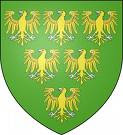Today is the anniversary of Piers Gaveston's death. I can't bring myself to call it execution, as that would suggest some sort of trial and for Piers to be guilty of a crime that merited the death sentence. To be snatched from the custody of someone sworn to protect his life with the sole aim to kill him cannot be termed an 'execution' - rather it was murder. Piers certainly broke the ban on his exile - enforced by jealous nobles against the king's will. His crime for being exiled? Being a bad influence on Edward II, being a Gascon, not accepting his place in society, enjoying the good life and having a sharp tongue. None of this merits a death sentence.
Guy of Warwick, who literally kidnapped Piers, quaked in his boots at murdering Piers on his land. Piers was marched from Warwick Castle until he reached Blacklow Hill. Warwick didn't even accompany him, leaving it to Thomas of Lancaster to carry out the deed. According to one chronicle, Lancaster refused to witness the killing of Piers, asking only to see the head afterwards. It had need decided to cut off Piers' head, awarding him this dignity because he had been an Earl. Yet the chronicler says that first, Piers was run through with a sword first, then beheaded. Why? It could be because Piers might have tried to escape - highly unlikely, as once he fell into Warwick's clutches he must have known there would be no mercy. Besides, it seems there was more than one 'executioner' given the task. In my opinion, it was likely there was no-one who had actually beheaded someone before. They are merely described as two Welsh archers. I'm sure Lancaster didn't care how they did it, as long as head and body were eventually separated. I can only hope it was quick.
Afterwards, neither Lancaster or Warwick could be bothered to bury Piers are even take charge of the body. Lancaster left him where he died, and when some shoemakers came across the body and took it to Warwick Castle, Guy refused to accept it. Thankfully, some Dominican Friars took charge of his remains. The head was sewn back on and the body was taken to Oxford, where Piers literally lay in state until Edward could get his excommunication revoked and give him a Christian burial.
Today, there is a monument to Piers at Blacklow Hill, and surrounding streets/roads have been given his name. There is even a Gaveston Lodge just before you cross the fields to get to Blacklow Hill.
3 days ago



